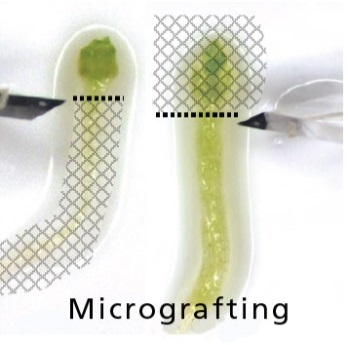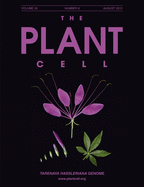Paper on long-distance transport in Plant Cell
Postdoc Tonni Grube Andersen and Associate Professor Hussam Nour-Eldin are shared first authors on a Plant Cell paper that shows organ-specific glucosinolate profiles in vegetative Arabidopsis.
Although it is essential for plant survival to synthesize and transport defense compounds, little is known about the coordination of these processes.
In this paper DynaMo researchers Tonni Grube Andersen, Hussam Nour-Eldin, Meike Buroe and Barbara Ann Halkier investigate the above- and belowground source-sink relationship of the defense compounds glucosinolates in vegetative Arabidopsis thaliana.
Grafting experiments
 Using in vivo feeding experiments they demonstrate that the glucosinolate transporters1 and 2 (GTR1 and GTR2), which are essential for accumulation of glucosinolates in seeds, are likely to also be involved in bidirectional distribution of glucosinolates between the roots and rosettes, indicating phloem and xylem as their transport pathways.
Using in vivo feeding experiments they demonstrate that the glucosinolate transporters1 and 2 (GTR1 and GTR2), which are essential for accumulation of glucosinolates in seeds, are likely to also be involved in bidirectional distribution of glucosinolates between the roots and rosettes, indicating phloem and xylem as their transport pathways.
By grafting of wild-type, biosynthetic, and transport mutants they show that both the rosette and roots are able to synthesize aliphatic and indole glucosinolates.
Organ-specific glucosinolate profiles
While rosettes constitute the major source and storage site for short-chained aliphatic glucosinolates, long-chained aliphatic glucosinolates are synthesized both in roots and rosettes with roots as the major storage site.
The team's grafting experiments thus indicate that in vegetative Arabidopsis, GTR1 and GTR2 are involved in bidirectional long-distance transport of aliphatic but not indole glucosinolates.
Their data further suggest that the distinct rosette and root glucosinolate profiles in Arabidopsis are shaped by long-distance transport and spatially separated biosynthesis, suggesting that integration of these processes is critical for plant fitness in complex natural environments.
Contact
Head of Center Professor Barbara Ann Halkier
DynaMo Center
Department of Plant and Environmental Sciences
University of Copenhagen
bah@plen.ku.dk
+45 35333342
The publication

Andersen, T. G.*, Nour-Eldin, H. H.*, Fuller, V. L., Olsen, C. E., Burow, M., Halkier, B. A.: Integration of biosynthesis and long-distance transport establish organ-specific glucosinolate profiles in vegetative Arabidopsis. Plant Cell, 25:3133-45, 2013.
